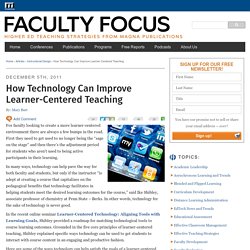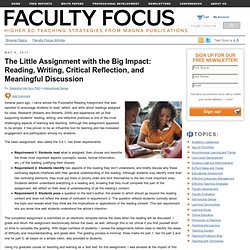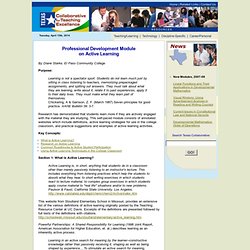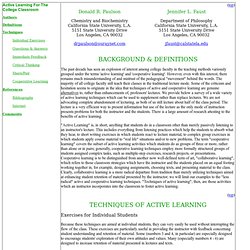

Clickers. How Technology Can Improve Learner-Centered Teaching. For faculty looking to create a more learner-centered environment there are always a few bumps in the road.

First they need to get used to no longer being the “sage on the stage” and then there’s the adjustment period for students who aren’t used to being active participants in their learning. In many ways, technology can help pave the way for both faculty and students, but only if the instructor “is adept at creating a course that capitalizes on the pedagogical benefits that technology facilitates in helping students meet the desired learning outcomes for the course,” said Ike Shibley, associate professor of chemistry at Penn State – Berks. In other words, technology for the sake of technology is never good. In the recent online seminar Learner-Centered Technology: Aligning Tools with Learning Goals, Shibley provided a roadmap for matching technological tools to course learning outcomes. Here are some of the ways technology can help satisfy the goals of a learner-centered classroom: 1. The Little Assignment with the Big Impact: Reading, Writing, Critical Reflection.
May 6, 2013 By: Geraldine Van Gyn, PhD in Instructional Design Several years ago, I came across the Purposeful Reading Assignment that was reported to encourage students to read, reflect, and write about readings assigned for class.

Research (Roberts and Roberts, 2008) and experience tell us that supporting students’ reading, writing, and reflective practices is one of the most challenging aspects of learning and teaching. Although this assignment appeared to be simple, it has proven to be an influential tool for learning and has increased engagement and participation among my students. The basic assignment, also called the 3-2-1, has three requirements: Requirement 1: Students read what is assigned, then choose and describe the three most important aspects (concepts, issues, factual information, etc.) of the reading, justifying their choices. The completed assignment is submitted on an electronic template before the class when the reading will be discussed. References Novak, G. Dr. Why Don't They Apply What They've Learned, Part I - Do Your Job Better. By James M.

Lang For two years I taught in a special program in which the same cohort of students took two consecutive courses with me: freshman composition in the fall and introduction to literature in the spring. In the composition courses, I worked hard to help students move beyond the standard strategies they had learned in high school for writing introductory paragraphs: Start with a broad statement about life ("Since the beginning of time, people have been fighting wars ...
") and narrow down to a specific topic. In both years that I taught the two-course sequence, I was startled to see many students come back from winter break and—on their very first papers in the spring class—revert directly back to those tired strategies that I had worked so hard to help them unlearn in the fall. One such student came into my office early in the spring semester to show me a draft of her paper, and it included a lame reverse-pyramid (i.e., general to specific) introduction.
D'oh! James M.
Activities for Active Learning. Active Learning. By Diane Starke, El Paso Community College Purpose: Learning is not a spectator sport.

Students do not learn much just by sitting in class listening to teachers, memorizing prepackaged assignments, and spitting out answers. They must talk about what they are learning, write about it, relate it to past experiences, apply it to their daily lives. They must make what they learn part of themselves. Research has demonstrated that students learn more if they are actively engaged with the material they are studying.
Key Concepts: Section 1: What is Active Learning? Active Learning is, in short, anything that students do in a classroom other than merely passively listening to an instructor's lecture. This website from Stoutland Elementary School in Missouri, provides an extensive list of the various definitions of active learning originally posted by the Teaching Resource Center at UC Davis. To locate more resources about active learning, visit this annotated bibliography: Tobin, K. (1986). D.C. Resources for Active Learning in the College Classroom. Role of Active Learning in Student Persistence. Active and Cooperative Learning.
The past decade has seen an explosion of interest among college faculty in the teaching methods variously grouped under the terms 'active learning' and 'cooperative learning'.

However, even with this interest, there remains much misunderstanding of and mistrust of the pedagogical "movement" behind the words. The majority of all college faculty still teach their classes in the traditional lecture mode. Some of the criticism and hesitation seems to originate in the idea that techniques of active and cooperative learning are genuine alternatives to, rather than enhancements of, professors' lectures.
We provide below a survey of a wide variety of active learning techniques which can be used to supplement rather than replace lectures. We are not advocating complete abandonment of lecturing, as both of us still lecture about half of the class period. Active Learning in College Classrooms.